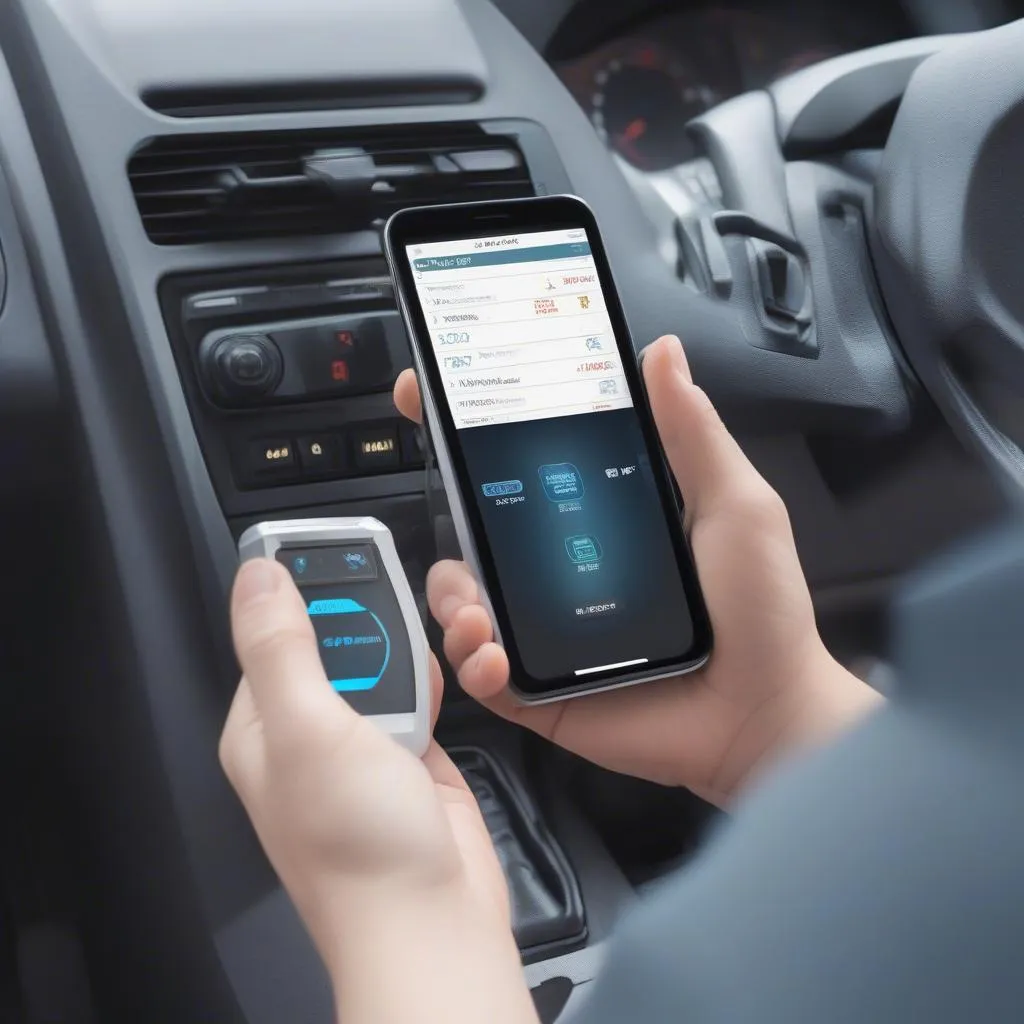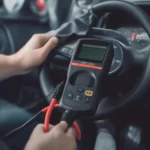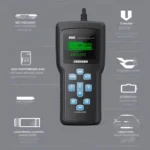Connecting a Bluetooth OBD2 scanner to your vehicle opens up a world of information about your car’s health and performance. Whether you’re a DIY mechanic or just curious about your car’s inner workings, a Bluetooth OBD2 scanner paired with your smartphone or tablet can provide invaluable insights. This guide will walk you through the simple steps of connecting your Bluetooth OBD2 scanner and start exploring your vehicle’s data.
Understanding Bluetooth OBD2 Scanners
Before diving into the connection process, let’s briefly discuss what a Bluetooth OBD2 scanner is and how it works.
A Bluetooth OBD2 scanner is a compact device that plugs into your vehicle’s OBD2 port, typically located under the dashboard on the driver’s side. It communicates with your car’s computer, retrieving diagnostic information and transmitting it wirelessly to your smartphone or tablet via Bluetooth.
Steps to Connect Your Bluetooth OBD2 Scanner
Connecting your Bluetooth OBD2 scanner is a straightforward process. Here’s a step-by-step guide to get you started:
-
Locate Your Vehicle’s OBD2 Port: The OBD2 port is usually located under the dashboard on the driver’s side. It’s a trapezoidal 16-pin connector.
-
Plug in the Bluetooth OBD2 Scanner: Insert the scanner firmly into the OBD2 port. The scanner should fit snugly.
-
Turn On Your Vehicle’s Ignition: Turn the key to the “on” position but don’t start the engine. This will power up the OBD2 port and the scanner.
-
Enable Bluetooth on Your Smartphone or Tablet: Go to your device’s settings and turn on Bluetooth.
-
Pair Your Device with the Scanner: Your device should display a list of available Bluetooth devices. Look for the name of your OBD2 scanner (it may appear as a series of numbers and letters) and select it to pair.
-
Launch Your OBD2 App: Open the OBD2 scanner app you’ve downloaded on your device. Many free and paid apps are available, each offering different features and data displays.
-
Connect to the Scanner: Within the app, select the option to connect to your OBD2 scanner. The app will then establish communication with the scanner.
Troubleshooting Connection Issues
If you encounter problems connecting your Bluetooth OBD2 scanner, consider these troubleshooting tips:
-
Check Compatibility: Ensure your OBD2 scanner and chosen app are compatible with your vehicle’s make, model, and year.
-
Verify Bluetooth Connection: Double-check that Bluetooth is enabled on your device and that the scanner is paired correctly.
-
Try a Different App: Some apps are more stable or compatible with specific scanners. Experimenting with different apps can help pinpoint compatibility issues.
-
Restart Devices: Try restarting both your smartphone/tablet and your vehicle. This can resolve temporary communication glitches.
-
Consult the Manuals: Refer to the user manuals for your OBD2 scanner and chosen app for specific instructions and troubleshooting steps.
Benefits of Using a Bluetooth OBD2 Scanner
Connecting a Bluetooth OBD2 scanner to your vehicle empowers you with valuable information and capabilities:
-
Diagnose Engine Problems: Read and clear diagnostic trouble codes (DTCs), also known as “check engine” lights, to identify potential issues.
-
Monitor Vehicle Performance: Track parameters like engine RPM, coolant temperature, speed, and fuel efficiency in real time.
-
Customize Driving Experience: Some advanced scanners allow for performance tuning, enabling you to adjust certain vehicle settings.
-
Stay Informed About Your Car’s Health: Regular scans can help detect potential problems early on, saving you time and money on costly repairs.
Conclusion
Connecting a Bluetooth OBD2 scanner is a simple yet powerful way to gain insights into your vehicle’s performance and health. By following these steps, you can easily connect your scanner, access valuable data, and potentially save on repair costs by identifying problems early. Whether you’re a seasoned mechanic or a car enthusiast, a Bluetooth OBD2 scanner is an invaluable tool for understanding and maintaining your vehicle.
FAQs About Connecting Bluetooth OBD2 Scanners
Q: Will any OBD2 scanner work with my car?
A: Not necessarily. Ensure the scanner supports your car’s make, model, and year. You can often find compatibility information on the scanner packaging or the manufacturer’s website.
Q: Do I need an internet connection to use a Bluetooth OBD2 scanner?
A: While an active internet connection isn’t always required, some apps may need it to download vehicle-specific data or provide additional features.
Q: Can I leave the OBD2 scanner plugged in all the time?
A: It’s generally safe to leave the scanner plugged in, but it’s best to unplug it when not in use to prevent potential battery drain.
Q: Are Bluetooth OBD2 scanners accurate?
A: The accuracy depends on the quality of the scanner and the app you’re using. Reputable brands and well-rated apps generally provide reliable data.
Q: Can I use a Bluetooth OBD2 scanner on multiple vehicles?
A: Yes, you can use the same scanner on different vehicles as long as they are OBD2 compliant (most vehicles manufactured after 1996).
Still, have questions about OBD2 scanners? Check out these helpful resources:
Need assistance connecting your Bluetooth OBD2 scanner? Contact our expert team via WhatsApp at +1(641)206-8880 or email us at [email protected]. We’re here to help 24/7.


